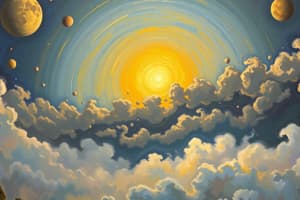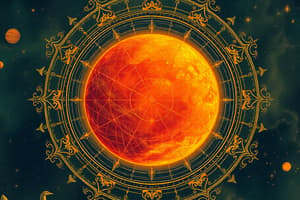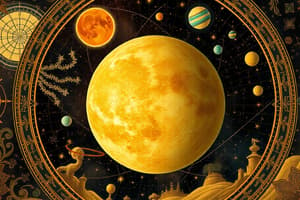Podcast
Questions and Answers
The Solar System consists of the Sun and the celestial bodies that orbit it, including planets, moons, asteroids, comets, and ______.
The Solar System consists of the Sun and the celestial bodies that orbit it, including planets, moons, asteroids, comets, and ______.
meteoroids
Venus is often called Earth's 'sister ______'.
Venus is often called Earth's 'sister ______'.
planet
Mars is known as the 'Red ______' due to iron oxide on its surface.
Mars is known as the 'Red ______' due to iron oxide on its surface.
Planet
Jupiter is known for its Great Red ______, a massive storm.
Jupiter is known for its Great Red ______, a massive storm.
The Sun accounts for approximately ______% of the Solar System's total mass.
The Sun accounts for approximately ______% of the Solar System's total mass.
Uranus rotates on its ______; it has an extreme axial tilt.
Uranus rotates on its ______; it has an extreme axial tilt.
The Kuiper Belt is a region beyond Neptune populated with small icy bodies and ______ planets.
The Kuiper Belt is a region beyond Neptune populated with small icy bodies and ______ planets.
Comets release gas and dust, forming a glowing ______ and tail when close to the Sun.
Comets release gas and dust, forming a glowing ______ and tail when close to the Sun.
Terrestrial planets have a definitive solid surface and are primarily composed of hydrogen and helium.
Terrestrial planets have a definitive solid surface and are primarily composed of hydrogen and helium.
Jupiter and Saturn are classified as ice giants.
Jupiter and Saturn are classified as ice giants.
The atmosphere of Ice Giants is rich in water, ammonia, and methane.
The atmosphere of Ice Giants is rich in water, ammonia, and methane.
Gas giants have strong magnetic fields and prominent ring systems, especially Saturn.
Gas giants have strong magnetic fields and prominent ring systems, especially Saturn.
Mercury has a well-defined atmosphere that supports life.
Mercury has a well-defined atmosphere that supports life.
Flashcards are hidden until you start studying
Study Notes
Overview of the Solar System
- The Solar System consists of the Sun and the celestial bodies that orbit it, including planets, moons, asteroids, comets, and meteoroids.
The Sun
- The Sun is a G-type main-sequence star (G dwarf).
- It accounts for approximately 99.86% of the Solar System's total mass.
- Core processes involve nuclear fusion, primarily converting hydrogen into helium.
Planets
-
Mercury
- Closest planet to the Sun.
- Smallest planet in the Solar System.
- Lacks a substantial atmosphere.
-
Venus
- Similar size to Earth; often called Earth's "sister planet."
- Thick, toxic atmosphere primarily composed of carbon dioxide.
- Extremely high surface temperatures due to the greenhouse effect.
-
Earth
- The only known planet to support life.
- Diverse climates and environments.
- Has one natural satellite (the Moon).
-
Mars
- Known as the "Red Planet" due to iron oxide (rust) on its surface.
- Has the largest volcano (Olympus Mons) and canyon (Valles Marineris) in the Solar System.
- Suspected to have had water in the past.
-
Jupiter
- The largest planet in the Solar System.
- Known for its Great Red Spot, a massive storm.
- Has a strong magnetic field and 79 known moons, including Ganymede (the largest moon).
-
Saturn
- Famous for its prominent ring system.
- The second-largest planet in the Solar System.
- Has 83 confirmed moons, including Titan, which has a thick atmosphere.
-
Uranus
- An ice giant with a blue-green color due to methane in its atmosphere.
- Rotates on its side; has an extreme axial tilt.
- Has 27 known moons and a faint ring system.
-
Neptune
- The farthest planet from the Sun; another ice giant.
- Known for strong winds and storms.
- Has 14 known moons, with Triton being the largest.
Dwarf Planets
- Pluto: Formerly classified as the ninth planet, now recognized as a dwarf planet.
- Other notable dwarf planets include Eris, Haumea, and Makemake.
Asteroids and Comets
- Asteroids: Primarily found in the asteroid belt between Mars and Jupiter; composed mainly of rock and metal.
- Comets: Icy bodies that release gas and dust, forming a glowing coma and tail when close to the Sun.
Kuiper Belt and Oort Cloud
- Kuiper Belt: A region beyond Neptune populated with small icy bodies and dwarf planets.
- Oort Cloud: A hypothetical spherical shell surrounding the Solar System, believed to be the source of long-period comets.
Key Facts
- The Solar System is about 4.6 billion years old.
- It formed from the gravitational collapse of a region within a large molecular cloud.
- The orbits of the planets are elliptical, mostly following Kepler's laws of planetary motion.
Overview of the Solar System
- The Sun and its orbiting celestial bodies make up the Solar System, including planets, moons, asteroids, comets, and meteoroids.
The Sun
- The Sun is a medium-sized star, a G-type main-sequence star (G dwarf).
- It makes up almost all the mass of the Solar System, with only about 0.14% remaining for the other objects.
- Nuclear fusion, primarily converting hydrogen into helium, occurs within its core.
Planets
- Mercury:
- Closest planet to the Sun and the smallest in the Solar System.
- It doesn't have a substantial atmosphere.
- Venus:
- Similar size to Earth and often called its "sister planet."
- Has a thick, toxic atmosphere primarily composed of CO2.
- Extremely high temperatures on its surface due to the greenhouse effect.
- Earth:
- The only planet known to sustain life.
- It has diverse climates and environments.
- Only planet with a natural satellite, the Moon.
- Mars:
- Known as the "Red Planet" because of its iron oxide.
- Home to the largest volcano (Olympus Mons) and canyon (Valles Marineris) in the Solar System.
- Evidence exists that water likely flowed on Mars in the past.
- Jupiter:
- The largest planet in the Solar System.
- Known for its Great Red Spot, a massive storm.
- It has a strong magnetic field and at least 79 known moons, including Ganymede, which is the largest moon.
- Saturn:
- Famous for its prominent ring system.
- The second-largest planet in the Solar System.
- Has at least 83 confirmed moons, including Titan, notable for having a thick atmosphere.
- Uranus:
- An ice giant with a blue-green color due to methane in its atmosphere.
- Known for its unusual axial tilt, as it rotates on its side.
- Has 27 known moons and a faint ring system.
- Neptune:
- The farthest planet from the Sun, another ice giant.
- Known for its strong winds and storms.
- Has 14 known moons, with Triton being the largest.
Dwarf Planets
- Pluto: Previously classified as the ninth planet, is now recognized as a dwarf planet.
- Other notable dwarf planets include Eris, Haumea, and Makemake.
Asteroids and Comets
- Asteroids: Primarily found in the asteroid belt between Mars and Jupiter, primarily composed of rock and metal.
- Comets: Icy bodies releasing gas and dust, forming a glowing coma and tail when close to the Sun.
Kuiper Belt and Oort Cloud
- Kuiper Belt: Region beyond Neptune, populated with small icy bodies and dwarf planets.
- Oort Cloud: A hypothetical spherical shell surrounding the Solar System, believed to be the source of long-period comets.
Key Facts
- The Solar System is around 4.6 billion years old.
- It formed from the gravitational collapse of a region within a large molecular cloud.
- Planetary orbits are elliptical, mostly following Kepler's laws of planetary motion.
Terrestrial Planets
- Definition: Rocky planets with a solid surface.
- Examples: Mercury, Venus, Earth, Mars.
- Composition: Primarily silicate rocks and metals.
- Atmospheres: Have an atmosphere, except Mercury.
- Life: Earth is the only planet known to support life.
- Surface Features: Feature mountains, valleys, and craters.
Gas Giants
- Definition: Large planets primarily made of hydrogen and helium.
- Examples: Jupiter and Saturn.
- Surface: Lack a definitive solid surface.
- Atmospheres: Deep atmospheres with clouds and storms.
- Magnetic Fields: Possess strong magnetic fields.
- Rings: Have ring systems, especially prominent around Saturn.
- Moons: Numerous moons with some being large, including Ganymede and Titan.
Ice Giants
- Definition: Planets primarily composed of water, ammonia, methane and other volatile substances.
- Examples: Uranus and Neptune.
- Atmospheres: Extensive atmospheres rich in ices and gases.
- Appearance: Distinctive blue color due to methane in the atmosphere.
- Weather: Experience strong winds and storms, particularly on Neptune.
- Rings: Have less prominent rings compared to gas giants.
- Moons: Fewer moons than gas giants, with notable ones being Triton and Miranda.
Studying That Suits You
Use AI to generate personalized quizzes and flashcards to suit your learning preferences.




